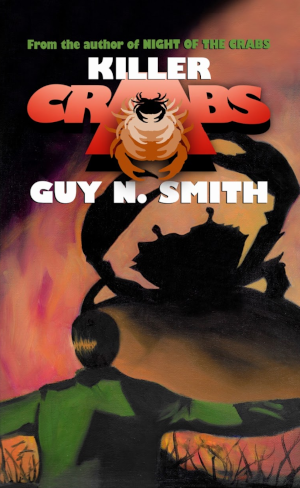
In 1976, biologist Professor Davenport led the British military in defeating monstrous crabs off the Welsh coast of Britain, saving the rest of humanity from a deadly fate. Or so he hoped. Four years later, in 1980, trawling Norwegian fishermen discover a giant crab in their catch. The crustacean makes a light snack of a crew member before disappearing back into the murky waters and the captain’s intended warning never reaches the authorities. A powerful crab colony moves on undetected, in search of its next feast. 8,000 miles away, fishermen are vanishing off the coast of Queensland, Australia. Mackay locals suspect foul play by rival fishing gangs until residents at the exclusive holiday resort of Hayman Island also find themselves on the crabs’ menu. Can the government, with Davenport’s help, seek out and destroy the monsters’ underwater hideout before the next full moon? Or will there be another banquet of death? Killer Crabs is the second book in Guy N. Smith’s iconic pulp horror Crabs series.
Plot Summary

In the annals of horror, few creatures strike fear into the hearts of humanity quite like the grotesque monstrosities depicted in this chilling narrative. With claws capable of rending flesh and bone with ease, and shells impervious even to the mightiest naval artillery, these abominations defy all conventional understanding of the natural order. Their eyes, glowing with a malevolent light, betray the depths of their depravity as they unleash unspeakable horrors upon their hapless victims.
Indeed, the world has never borne witness to such a formidable army of creatures, whose very existence seems to defy all logic and reason. With each merciless attack, they revel in the agony of their prey, their twisted grins serving as a grim testament to their sadistic nature. As they tear limb from limb and sow chaos and destruction in their wake, they embody the very essence of terror incarnate.
In the face of such relentless and unfathomable evil, humanity finds itself teetering on the brink of annihilation, grappling with forces beyond comprehension. With each passing moment, the threat posed by these nightmarish entities grows ever more dire, leaving mankind to ponder whether salvation is even possible in the face of such overwhelming darkness.
As readers are drawn deeper into the harrowing depths of this narrative, they are confronted with the chilling realisation that the true horror lies not only in the creatures themselves, but in the knowledge that they may never be vanquished. In a world besieged by malevolence and despair, hope flickers dimly on the horizon, a fragile beacon in the encroaching darkness.
Themes and Style
- Nature’s Revenge: “Killer Crabs” explores the theme of nature turning against humanity, with the mutated crabs representing the ecological consequences of human negligence and environmental destruction.
- Action and Suspense: The novel is characterised by its fast-paced action sequences and suspenseful encounters with the giant crabs, keeping readers on the edge of their seats throughout.
- Environmental Commentary: Like other books in the series, “Killer Crabs” incorporates themes of pollution and the consequences of human activity on the natural world, reflecting Smith’s concerns about environmental degradation.
Reception
“Killer Crabs” received positive reviews from fans of the series and readers of horror fiction. The novel’s blend of thrilling action, gruesome horror, and ecological commentary resonated with audiences, making it a cult classic among creature-feature horror enthusiasts.
Author Background
Guy N. Smith (1939-2020) was a British author known primarily for his horror fiction. With over 100 novels to his name, Smith’s works often featured elements of the supernatural, the macabre, and the grotesque. He gained widespread recognition for his “Crabs” series, which became a beloved franchise among horror fans.
Legacy
“Killer Crabs” remains a beloved classic in the creature-feature horror genre, spawning multiple sequels and adaptations. Its enduring popularity speaks to Guy N. Smith’s talent for creating memorable and terrifying tales of ecological terror, capturing the imaginations of readers for decades.